The larger the organization, the more data it generates. Data can provide valuable intelligence, or it can be a dead weight just taking up space on the servers. And the more data there is, the harder it is to manage.
Disorganized data, manual data sorting, and opaque data processes can seriously impact productivity. This is further complicated by the need to comply with regulations that dictate what can and cannot be done with data.
If you recognize your company in the above paragraph, you urgently need to set up a system for secure enterprise data management that covers the protection, processing, and use of data.
In this article, Intellias data and analytics service experts explain how to build an enterprise data management strategy, what problems it will help you solve, and what you will get as a result.
Benefits and challenges of enterprise data management
Reducing the data chaos by optimizing operations
When speaking about the importance of enterprise data management, this is the first thing to mention. Without EDM, information may be communicated inaccurately. Data may get stuck in bottlenecks and become difficult to find and use.
Hewlett Packard’s Data Innovations Guide states data volumes as one of the key challenges in data management. EDM can significantly reduce the hustle around data, providing a standardized and streamlined approach to handling large volumes of information.
Challenges of data management
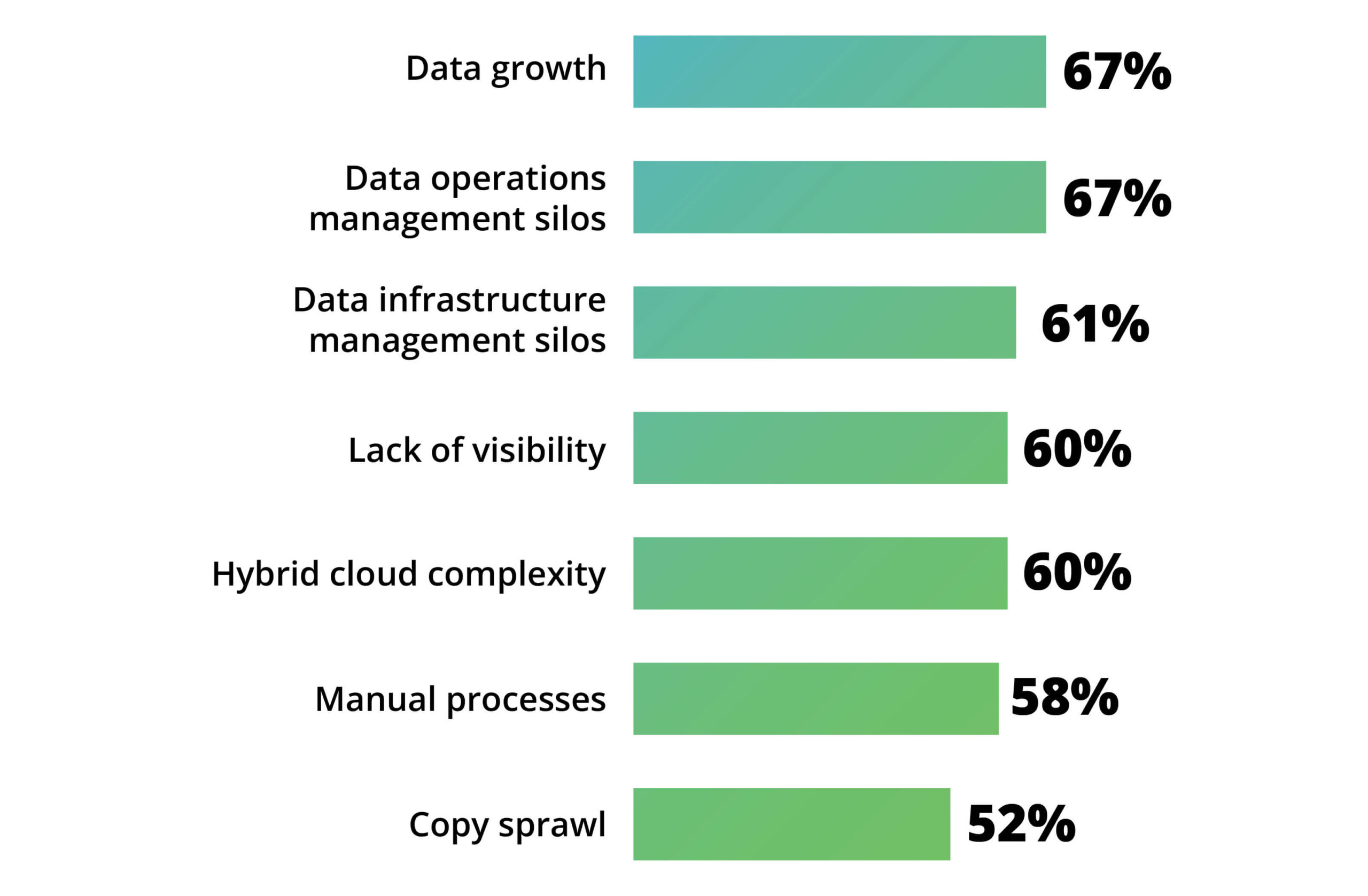
Source: CIO
Improved data quality and better decision-making
Poor-quality data is of little or no use to the company and creates unnecessary manual work for employees. When data is stored in different formats and in different silos, and when it contains noise, it becomes impossible to draw conclusions based on it.
EDM eliminates all of the above. Data becomes unified and standardized. It also becomes easier to process, and therefore can be transformed into business intelligence for decision-making.
One Intellias illustrates how an enterprise data management strategy can help drive impressive results. We helped a US-based cloud communications platform implement real-time data analytics. This enabled the client to make much better strategic decisions, which resulted in a 30% revenue increase and two million users in two years.
Increased data protection and regulatory compliance
The worst thing that can happen to a company’s data is a leak. Especially if that data is sensitive. In that case, the company will have problems with everyone from customers to regulators. In May 2023, Meta was fined €1.2 billion (over $1.3 million) for violating the GDPR. Such incidents are especially devastating for the healthcare industry. In 2019, the Magellan Health data breach resulted in USD 1.43 million in payments to affected patients.
One of the key benefits of enterprise data management is that it allows you to handle data as securely as possible. By clearly understanding the data flow, an enterprise can implement practices and technologies to protect it.
Regulatory compliance is another important aspect. For example, the GDPR, the California Privacy Rights Act (CPRA), the Canadian PIPEDA, and the Irish DPA clearly regulate what can and cannot be done with personal information. By building EDM, you can adjust to these requirements and protect yourself from fines for non-compliance.
Adoption of new technologies and abandonment of outdated ones
EDM implies not only putting processes in order but also implementing cutting-edge technologies. Legacy systems, databases, and tools drag a company to the bottom and prevent it from fully realizing its competitive advantages.
By implementing EDM, you can equip your business with the latest technologies, including AI, and transfer infrastructure to the cloud. It is best when your implementation partner actively facilitates this. Intellias offers clients a convenient transition to new technologies.
We partner with top cloud vendors and have in-depth knowledge of their solutions, enabling us to offer the best terms for our clients when setting up cloud-based data platforms. Our experts are also always there to help with rapid technology adoption. Finally, when building EDM, we implement the most advanced technologies such as Snowflake, Databriks, and data architectures like data fabric and data mesh.
Reduced costs and increased efficiency
One of the key trials of companies without EDM is excessive manual work by employees. What good is an entire staff of analysts if they spend most of their time just finding the right document?
With EDM, working with data becomes much easier and more convenient, as employees always know how and where to find it.
Intellias has relevant experience in this area. One enterprise data management example is our project to build a data management solution for a European business in the loan management industry. By building a clear data management strategy, we were able to achieve a 10% decrease in average manual actions per case and a 20% cost efficiency increase through custom data infrastructure.
Enterprise data management vs. master data management
When it comes to data management, two similar terms — EDM and MDM — often come up. Although enterprise data management (EDM) and master data management (MDM) operate on the same plane, these concepts should not be confused. Their scopes, tasks, and responsibilities are different.
EDM is a more general concept. It encompasses all work with all of an organization’s data assets. EDM includes data governance, information quality, integration, data protection, etc.
MDM is one of the elements of enterprise data management and involves working only with master data. Master data is the most important company reference data, such as information about customers, suppliers, and processes.
Master data management consists of consolidating, cleaning, and synchronizing master data throughout the organization. This allows master data to be perceived as a single source of truth about business assets.
In other words, where EDM focuses on managing enterprise data for decision-making, MDM focuses only on business-critical items.
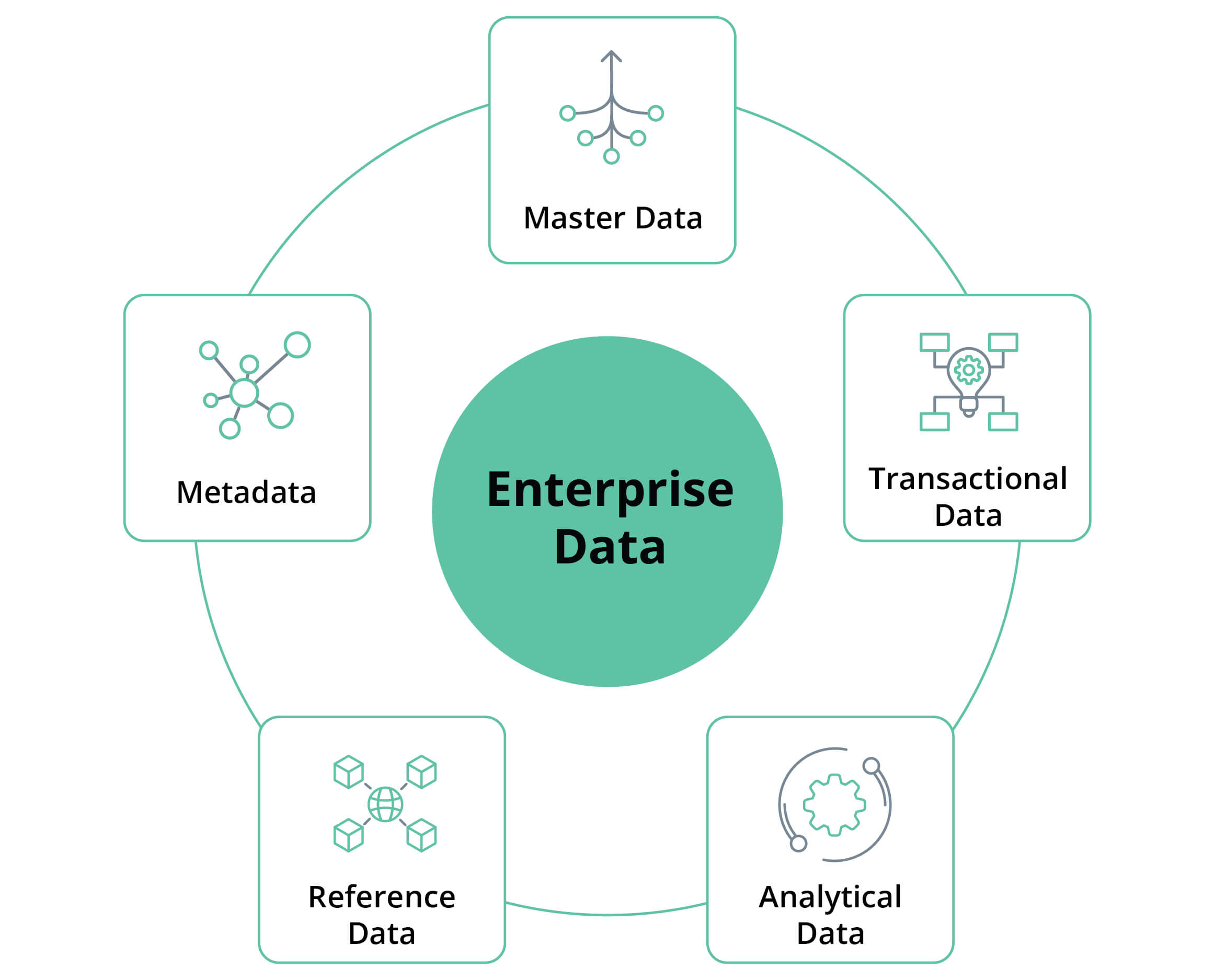
How to develop an enterprise data management strategy
It’s hard to imagine a more profitable investment than working with a reliable technology partner. According to Forrester’s research for data cloud company Collibra, companies relying on data insights are 58% more likely to achieve their revenue goals and 162% more likely to exceed them compared to their competitors. Furthermore, the Forrester study shows that these companies have a 173% advantage in complying with regulations.
Let’s take a look at the steps involved in building an enterprise data management strategy.
Define data management objectives
Any strategy starts with planning. You need to build a fault-tolerant structure that will work and yet be flexible enough to adjust when things go wrong.
To do this, you need to clearly define your business goals. When you know what outcome you need to achieve, you can make informed decisions.
Typical goals for implementing an enterprise data management strategy include:
- Easy and convenient access to data
- Maximizing the value of data and gaining valuable intelligence
- Ensuring the right level of data security
- Achieving regulatory compliance
- Reducing the time spent working with data
- Transparency in data handling
Evaluate the current state of data management
Next, you need to conduct a comprehensive audit of your current state of affairs: where your data comes from, how it is processed, and where it is stored.
This can be a lengthy process that requires the efforts of a large number of data scientists. Here are just some of the activities that need to be done.
- Define your current data architecture
- Analyze data flows
- Identify data sources, links between different systems, etc.
- Analyze stored data, its type, and its quantity; sort it by sensitivity; etc.
- Analyze data security, regulatory compliance, and access policies
- Analyze data quality metrics
- Identify current data and metadata management practices
All in all, you need to have a clear understanding of what your current data governance is. Large enterprises typically already have data management in place. The only question is how it can be improved.
Establish data governance
Finally, you need to clearly define policies for the key data governance components of the enterprise. You should clearly define standards for data quality, handling, and access. Here are just a few of the key aspects.
Master Data Management
With master data management, the enterprise will be able to avoid duplicates, aggregate reporting, and optimize processes related to critical data.
Data Quality
This is about monitoring data to ensure it meets common standards. Quality data, cleansed of unnecessary information and forming a unified database, will help avoid chaos in operations and redundant manual work.
Data Integration
This process involves integrating data from different sources into a single system. Controlling it will help you avoid errors and delays and will eventually increase productivity.
Data Security
This is an integral part of EDM. Data security policies should strictly regulate how to protect against leaks, theft, and cyberattacks.
Data Architecture
The data architecture allows you to understand the big picture of how data is handled in the enterprise. It is used to generate intelligence and create enterprise data model (EDM) graphs with an overview of where data comes from and how it is transformed and modeled.
Metadata Management
This component governs lineage traceability documents and business glossaries. Metadata allows for a clear understanding of data definitions, relationships, and movements.
Data Privacy
This component involves regulatory compliance. The GDPR, CCPA, and other regulations and laws govern the handling of sensitive information, and non-compliance can result in devastating reputational and financial risks.
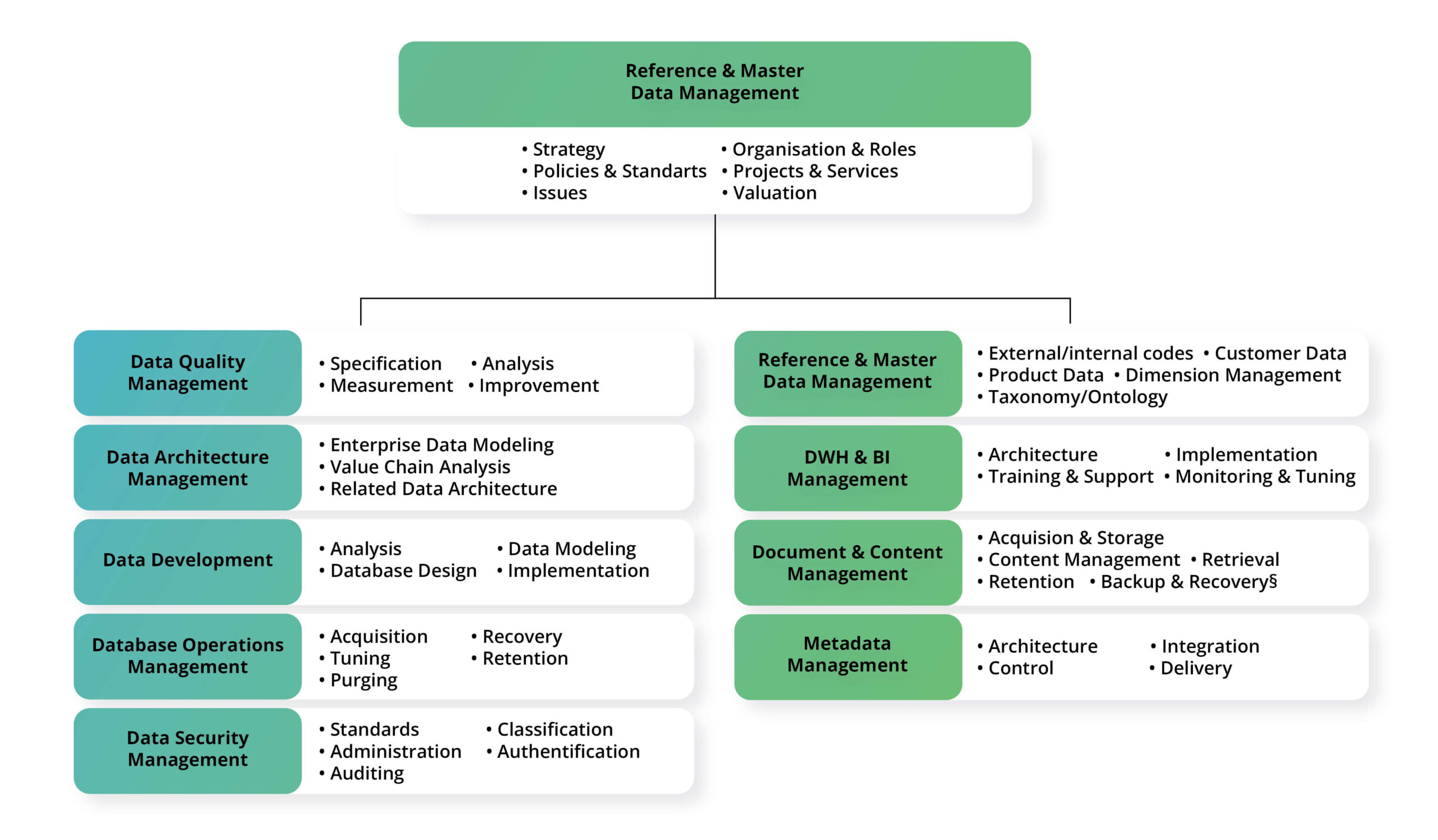
Source: DAMA
Enterprise data management best practices
Comprehensive assessment
To ensure the success of data management in the enterprise, you should identify strengths and weaknesses. For example, Intellias uses Data Management Maturity Assessment and Gap Analysis based on the Capability Maturity Model.
Data Management Maturity Assessment and Gap Analysis in Intellias is a structured assessment of an organization’s current data management practices against established maturity levels. The assessment uses the DMMA framework from DAMA.
Assessors evaluate various management areas including governance, architecture, and quality. Based on the assessment, experts can create a roadmap to fill the gaps and move to optimization. Data Management Maturity Assessment and Gap Analysis allows for building a comprehensive EDM in full compliance with the company’s business goals.
Leveraging the Enterprise Data Model
One of the best practices for enterprise data management is implementing an enterprise data model. In fact, this is an unbiased single-view model of the data produced and processed throughout the organization. It allows you to look at data in isolation from applications and systems and is one of the key elements of a data architecture.
The enterprise data model is built around three key elements:
- Enterprise Subject Area Model (ESAM) – a layer that defines enterprise data and separates it by subject.
- Enterprise Conceptual Model (ECM) – at this level, subjects are divided into separate segments called major business concepts. The interaction between different concepts and their attributes is defined here.
- Enterprise Conceptual Entity Model (ECEM) – This level defines business-critical data concepts from an enterprise-wide perspective.
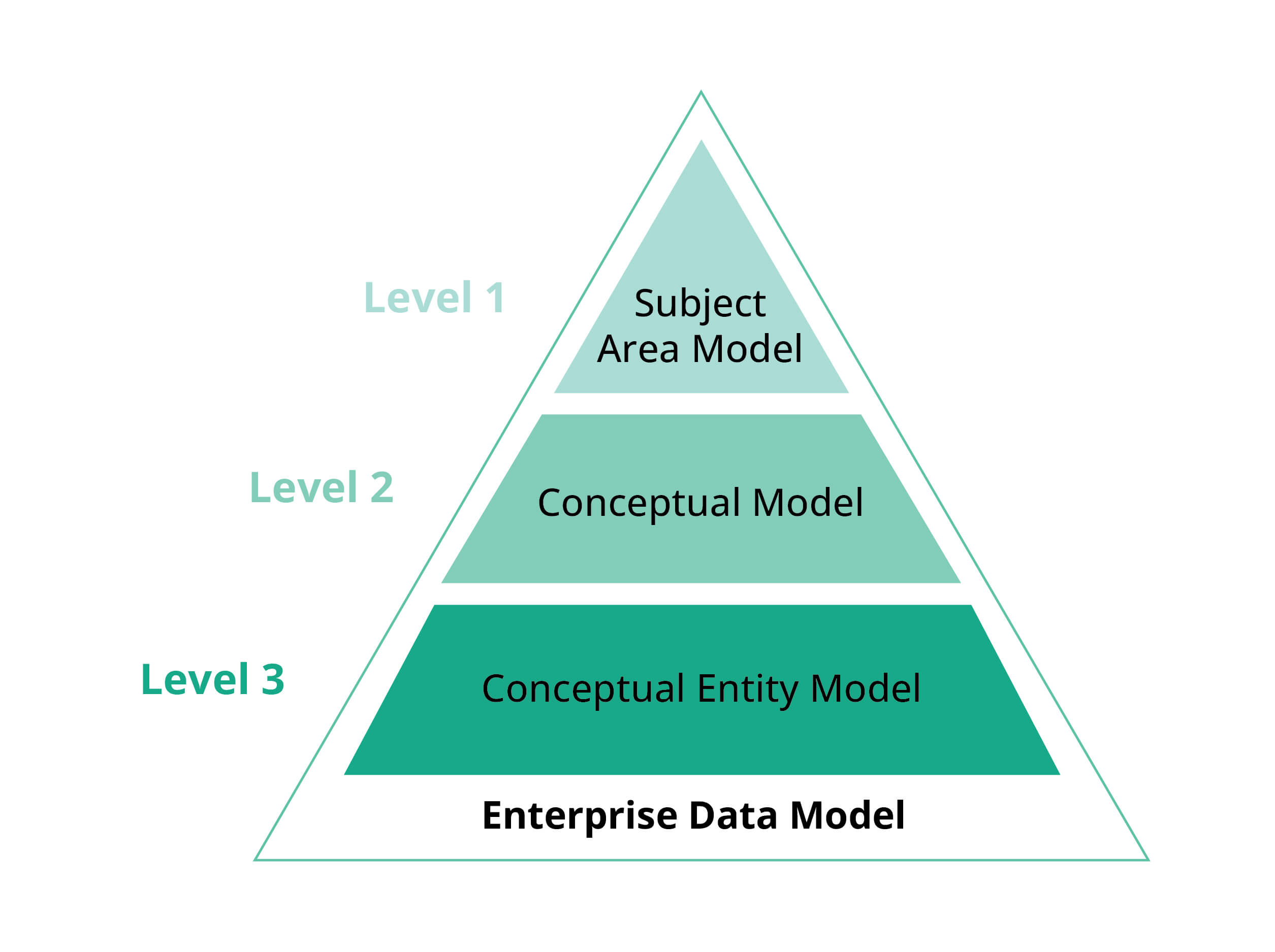
Source: TDAN
Together, these layers create an enterprise data model that provides a clear understanding of the pillars of data management.
Flexible data architecture
By making the enterprise data management architecture monolithic, you are cornering yourself. A data architecture should be able to adopt new technologies and change to meet the needs of your organization. This way, you can always respond to market challenges.
The key approaches for creating a flexible data architecture are data fabric and a data mesh, which we will explain below, and the concept of a data lakehouse.
A data lakehouse combines the concepts of a data lake and data warehouse. From the former, a data lakehouse takes the storage of data in raw unstructured form, which makes the system more flexible.
However, this data is combined into a common model optimized for analytical queries, which allows for efficient data integration and subsequent decision-making based on it.
Cooperating with experts
Don’t assume that you will be able to build an EDM solution on your own. Even if you have in-house data management experts, it will take them too much time and too many resources to redesign all processes for the new environment. It is better to turn to a reliable implementation partner who has experience in this niche and will help you do everything right.
Partnering with Intellias is the right way to build an all-encompassing data management strategy and leverage all of your data assets. We will take care of planning, design, implementation, and follow-up support for your strategy, along with providing engineering and data governance services.
We practice a customized approach to each case to ensure alignment with business objectives and maximize value. Our projects are a prime example of how data-driven solutions can increase revenue and provide a competitive advantage in the short and long term. Our experts have extensive experience solving challenges in EDM, including data silos, poor data quality, and outdated technologies.
Our work will result in a unified and efficient data ecosystem that transforms information into intelligence.
Employee training
EDM only works if all employees have the right level of expertise. Intellias offers client academies for enhancing niche skills and a Data and Analytics Center of Excellence for continuous upskilling of engineers and other specialists.
Learn how Intellias implements the best EDM practices to create data management platforms for telecom.
Future trends in enterprise data management
Generative AI
Your company may have terabytes of data. But what good is it if you’re not getting enough insights from it, if any? Generative AI is designed precisely to deal with huge amounts of data.
Using GenAI technology, you can ensure that all data is sorted, labeled, and stored in the proper form. These are just some of the use cases of this technology in data management:
Creating metadata. Generative AI is capable of organizing large amounts of data and creating descriptions for it.
Cleansing data. Data processed by GenAI can be cleaned of noise that has no real value to the enterprise.
Natural Language Processing. LLMs with data analytics can summarize data from human sources such as conversations, articles, and scripts. These extracts can then be retrieved simply by asking a question in natural language.
Anonymizing data. GenAI is able to anonymize sensitive data and provide understandable reports on it.
Improving data quality. GenAI can fill gaps, bring data into a common format, and combine different data sources automatically. Data engineering can significantly boost your company’s performance.
Generative AI is the future. Data science experts already expect that a large number of companies will apply generative AI in a wide range of activities. Management of enterprise data analytics is particularly well suited for this.
Generative AI impact on productivity by business functions
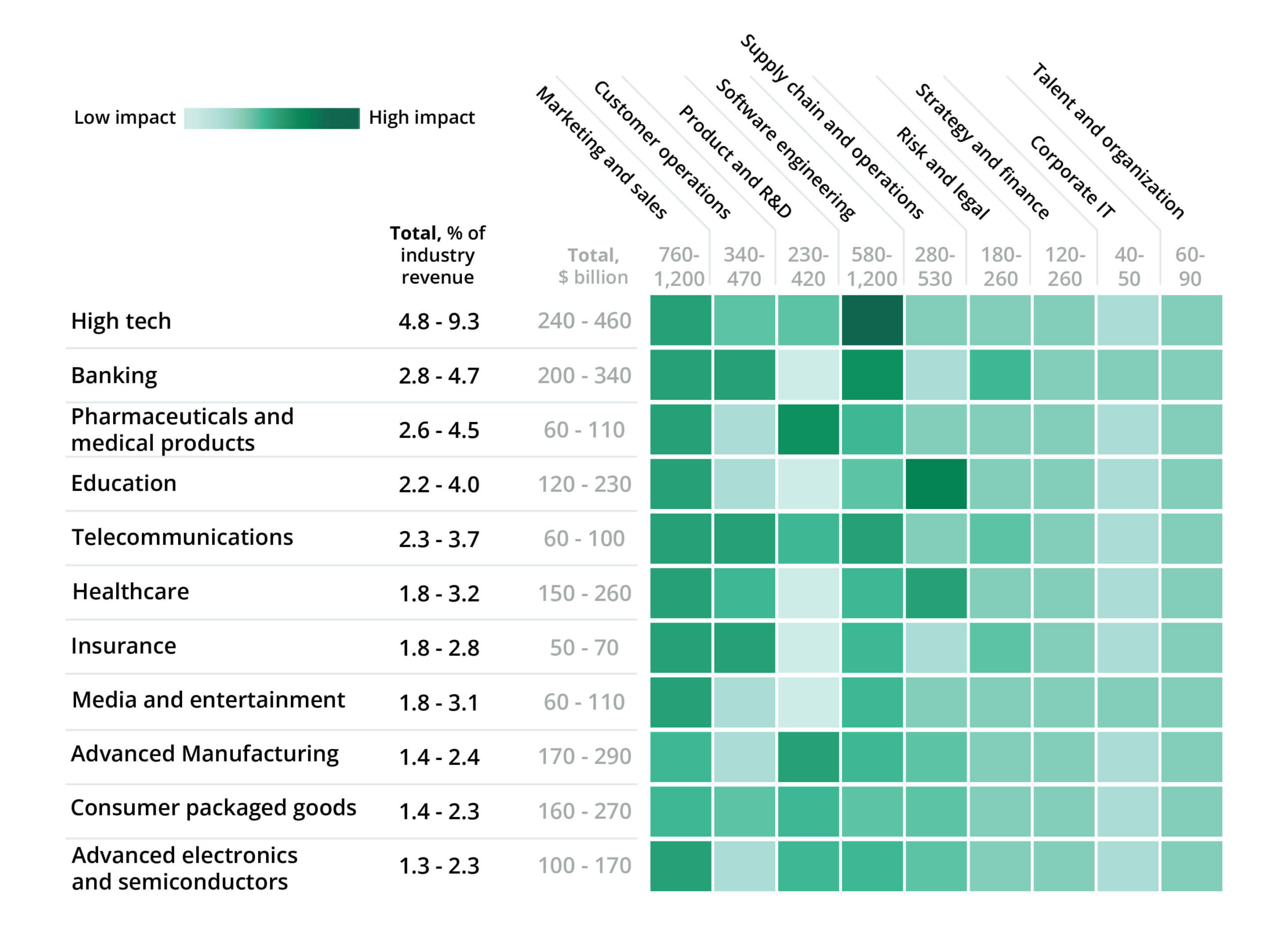
Source: McKinsey – The economic potential of generative AI
Data mesh
Data mesh is an approach to data management that involves creating a unified data pipeline. When multiple teams in a large enterprise are constantly producing data, it can become siloed, and analyzing it puts a burden on analytics teams. A data mesh helps eliminate this problem.
While a data lake is monolithic and centralized, a data mesh adds flexibility to the system. In doing so, data is standardized and aligned with common standards while coming from different sources.
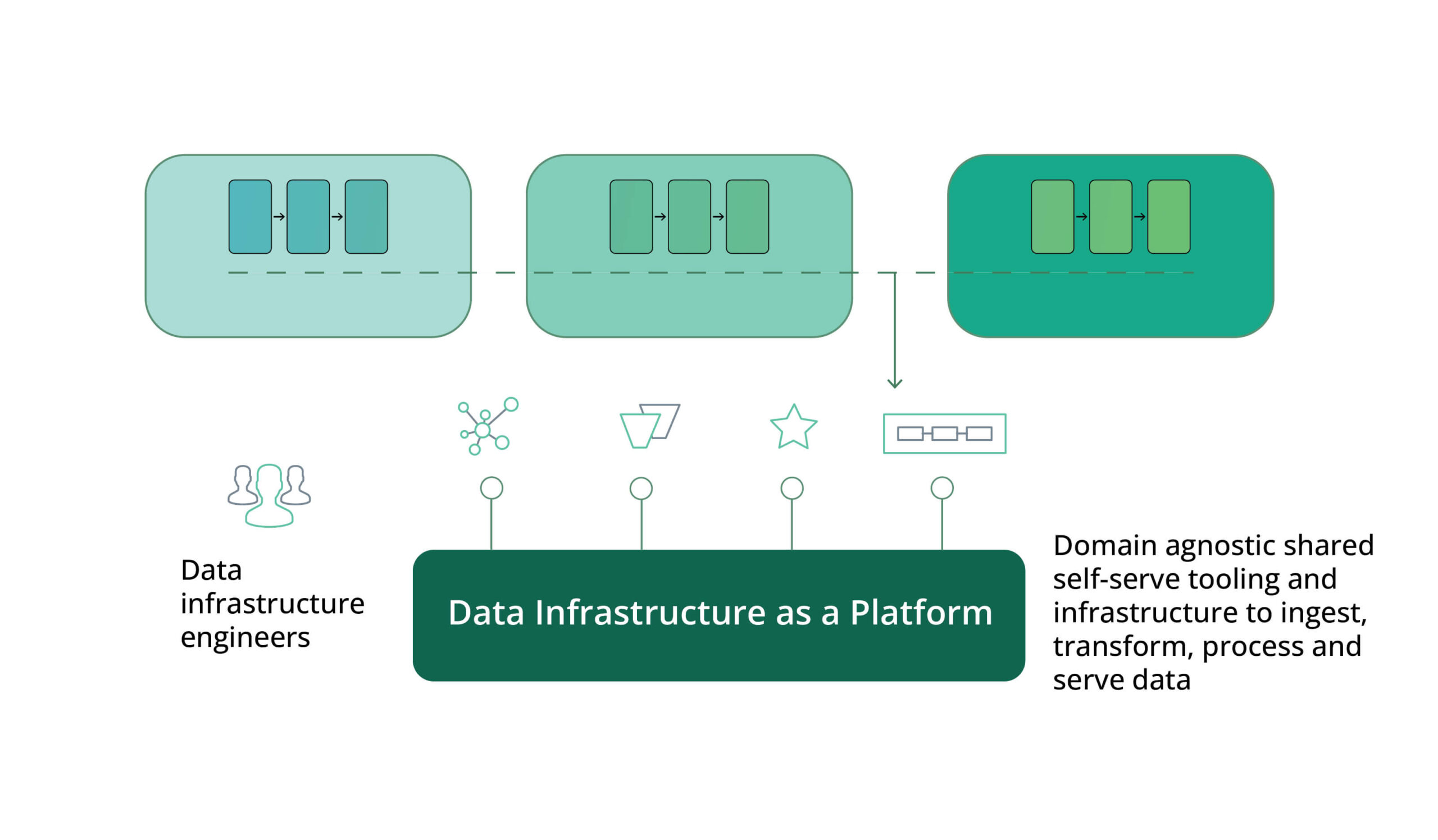
Source: How to Move Beyond a Monolithic Data Lake to a Distributed Data Mesh
As Zhamak Dehghani, the creator of the term data mesh, points out, such a data infrastructure is self-service. Applying this approach allows companies to enhance their processes with minimal or no investment.
Data fabric
A data fabric architecture applies artificial intelligence technologies and involves the digitalization of DataOps processes.
The essence of the data fabric architecture is step-by-step processing of information flows with the help of AI and ML.
A data fabric optimizes processing algorithms, automates analytics, and highlights the most important data aspects. It orchestrates data by implementing microservice architectures and cloud enterprise data management solutions. In doing so, the architecture allows for flexible customization of each user’s rights, resulting in increased security.
How Intellias can help you implement an enterprise data management system
Implementing an enterprise data management strategy is a complex process, but Intellias will help you ace it. We will use our expertise and capabilities to develop a data management strategy for you, provide DataOps and data engineering services, and implement AI/ML technologies to turn data into valuable insights for marketing and operations. We will also provide you with long-term support and build a resilient system that fully complies with all relevant laws and regulations. Contact us now to start implementing enterprise data management and make your business future-proof.


